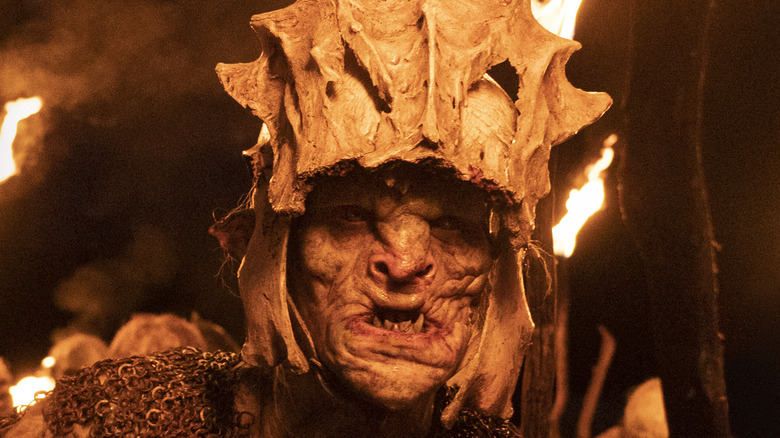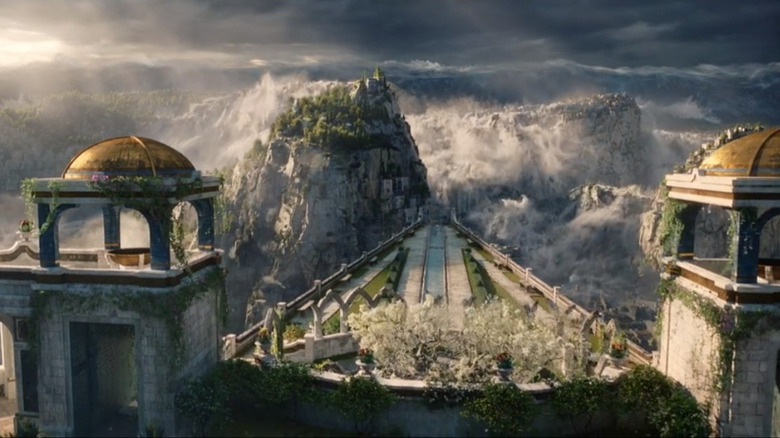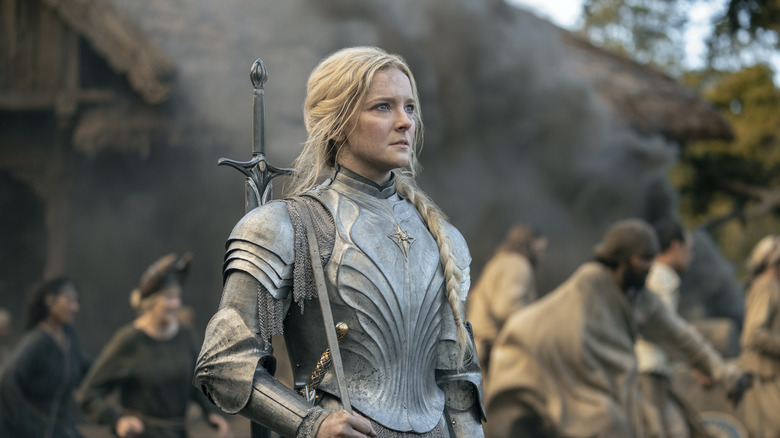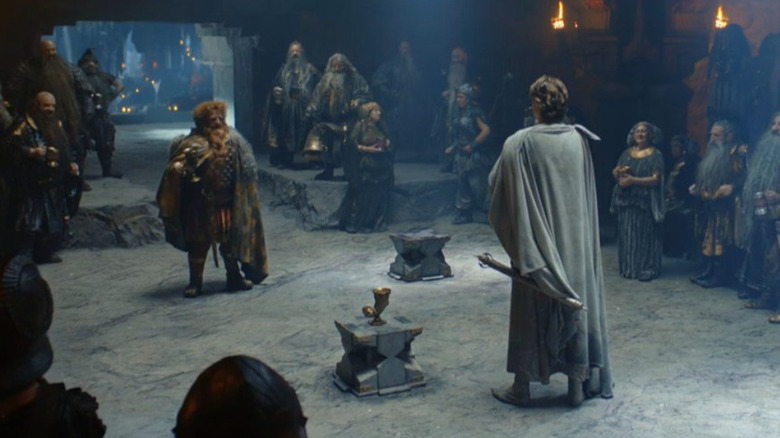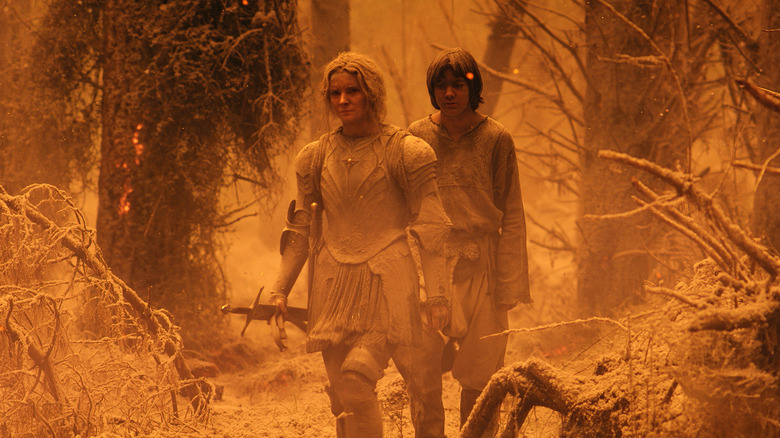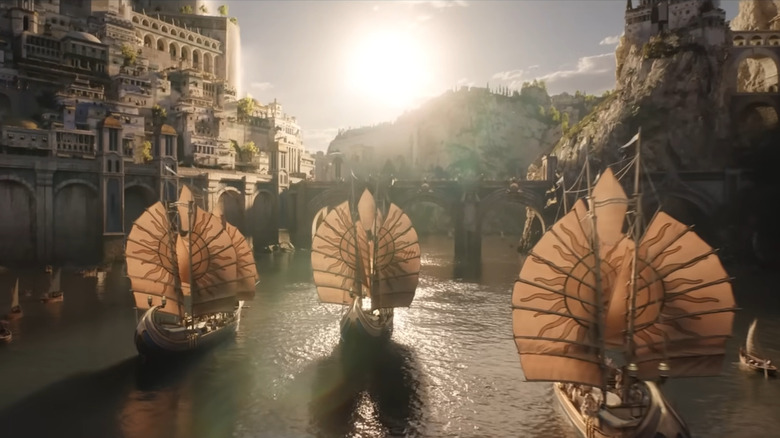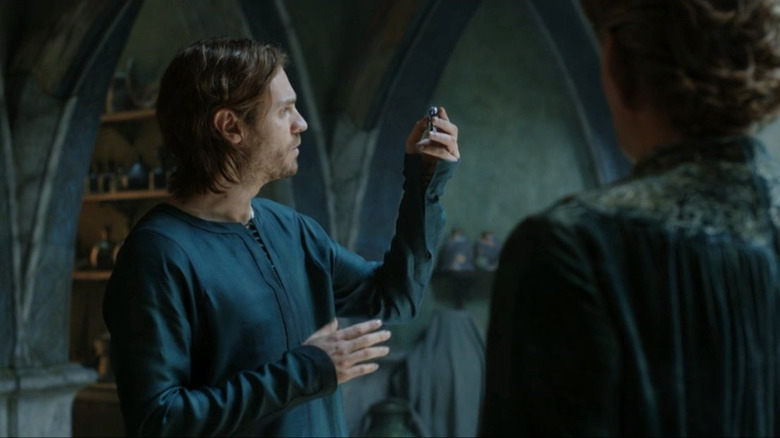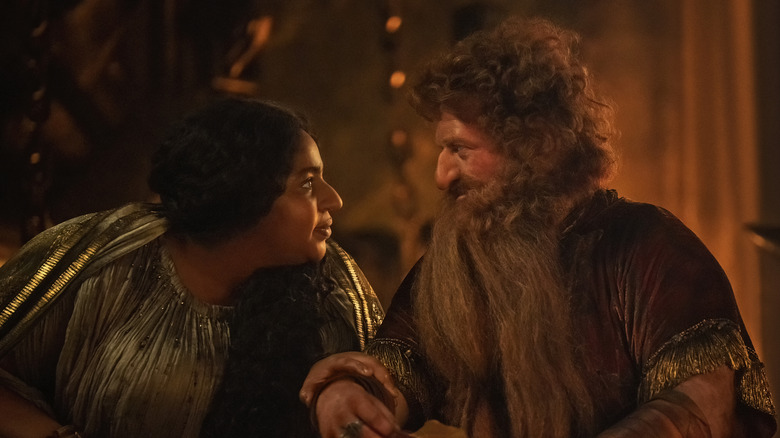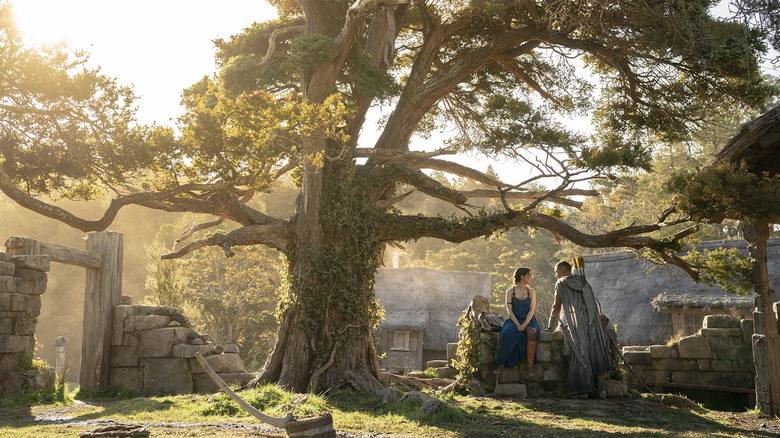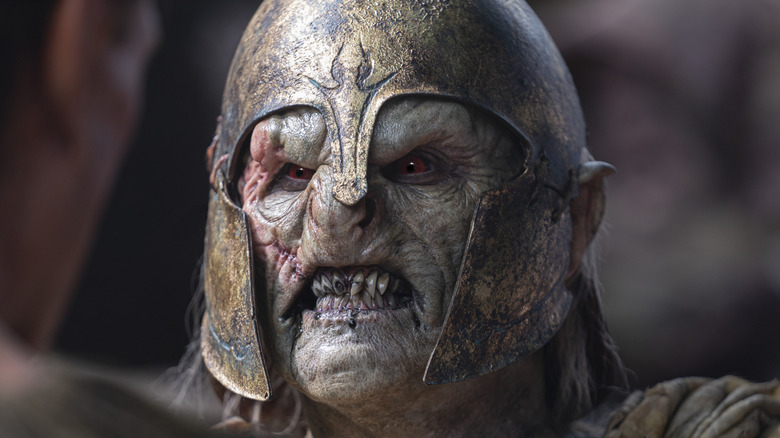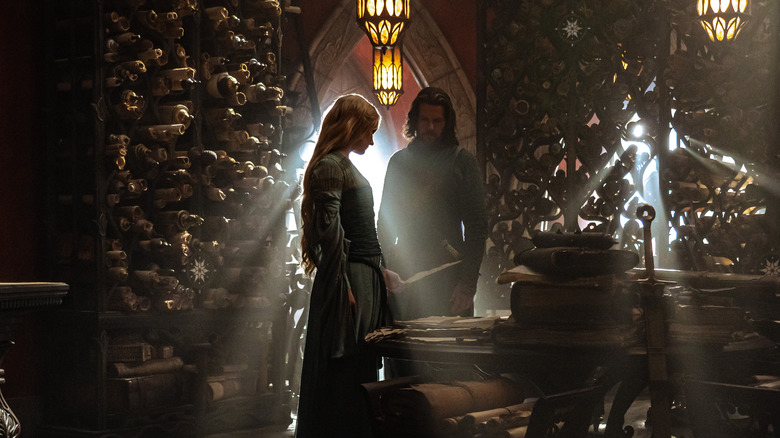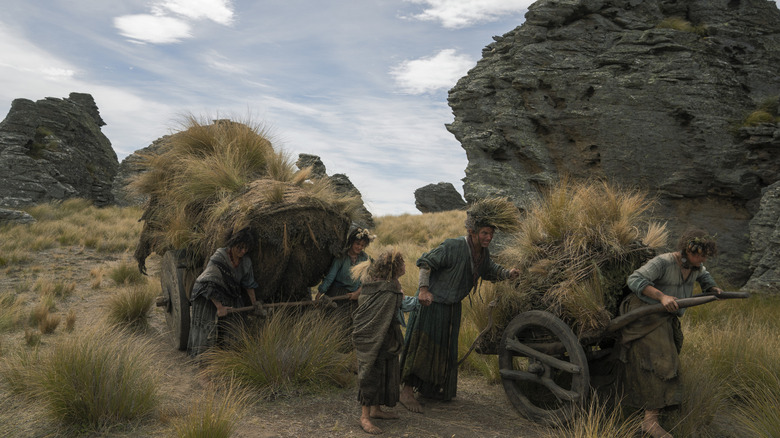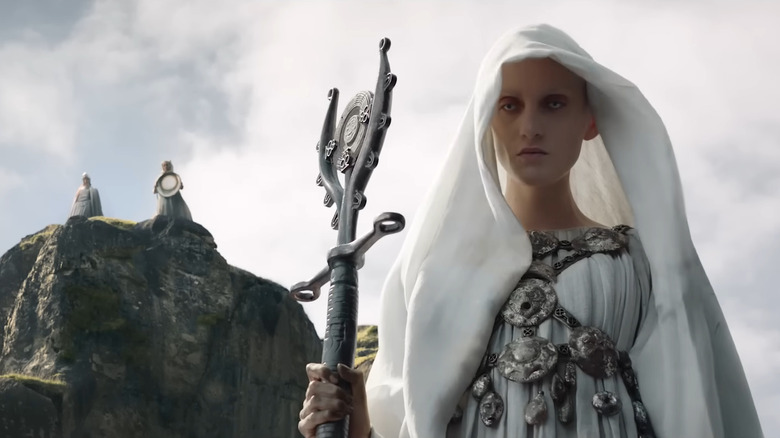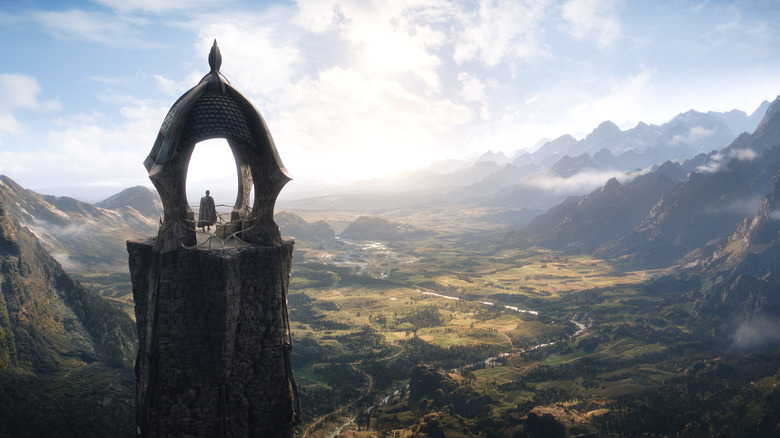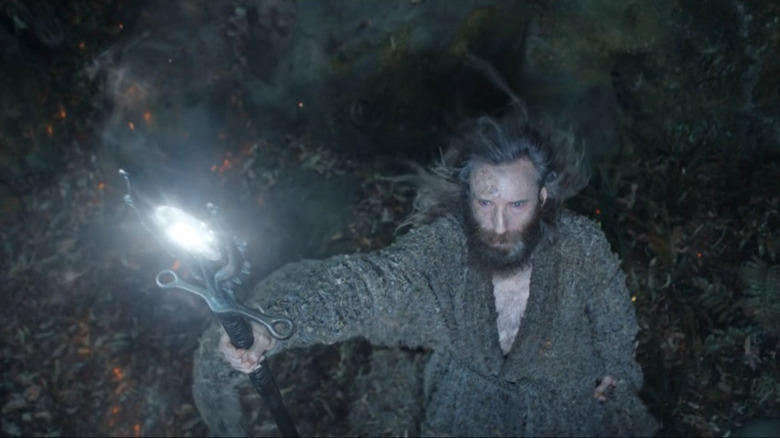The 7 Best And 7 Worst Things From The Lord Of The Rings: The Rings Of Power Season 1
After years of waiting, the first season of "The Lord of the Rings: The Rings of Power" has come and gone. The reception to Amazon Prime's Middle-earth show was a bit of a mixed bag. Many fans were excited to return to a cinematic version of Tolkien's world after a long hiatus following Peter Jackson's "The Hobbit" trilogy. Others were understandably nervous about a new group of creative minds tackling a fresh adaptation of the author's material. Still others were downright upset by the experience, criticizing everything from excessive lighting to a lack of Dwarvish female facial hair.
While extreme opinions can be found for most movie franchises these days, many viewers walked away from "The Rings of Power" with a decidedly unfavorable view. In honor of those who are willing to see both the good and the bad in something, we've pulled together a list highlighting some of the best and worst things about the first season of the series. Here they are in no particular order. Enjoy!
Best: The visuals are stunning
Let's kick things off with one of the most universally cited positive takeaways from the series: the visuals. One of the most well-established facts about "The Rings of Power" is that it has a big budget — especially for a serialized show on a streaming platform. It's perfectly valid to question some uses of this money, like the confusing and disjointed multi-month advertising campaign leading up to its premiere. One area that clearly translated to money well spent, though, is the show's stunning cinematic elements.
Everywhere you turn, showrunners JD Payne and Patrick McKay's rendition of Middle-earth is overloaded with jaw-dropping visuals. Some of these include sweeping panoramic shots of the familiar New Zealand landscape (where the first season was primarily filmed). Other shots are more disturbing in their grandeur, like the image of Mount Doom erupting in catastrophic fury. Still others are just plain impressive, like the fact that all of the red-infused, ash-covered Mordor scenes post-eruption were done without digital effects. From charging cavalry to sweeping countryside shots to awe-inspiring cityscapes (more on those elsewhere), the cinematic elements of "The Rings of Power" hold up to the standard set by Peter Jackson's previous trilogies and are, hands down, some of the show's greatest strengths.
Worst: Galadriel's one-dimensional need for vengeance
Galadriel is one of the coolest female characters in all of Tolkien's legendarium. The she-Elf is an immortal princess born in an undying land who sets out to visit the war-torn regions of Middle-earth. She does this because, as "The Silmarillion" puts it, "she yearned to see the wide unguarded lands and to rule there a realm at her own will." This leads her on a long journey through the First, Second, and Third ages of Middle-earth history. Over time, she becomes more important, especially as a key player in the never-ending wars against Sauron. She marries the Elven prince Celeborn and eventually becomes mother-in-law to Elrond Half-Elven. She wields one of the Three Elven Rings and keeps the wooded realm of Lothlorien safe.
The multi-dimensional aspects of Galadriel's personality and story are some of its most compelling elements. So when "The Rings of Power" unveiled a one-dimensional character hell-bent on a centuries-long mission to complete her brother's quest to vanquish Sauron, it understandably sat poorly with many viewers. The sheer obsession with finding and defeating Sauron dominates Galadriel's storyline throughout the first season (taking up gobs of screen time in the process). It crowds many other potential storylines for the future Lady of Lorien out of the picture. Hopefully, we'll see a more balanced, well-rounded, tempered character moving forward, if only so the show can cash in on many of the other interesting elements of one of Tolkien's most epic personalities.
Best: Elrond and Durin's relationship
There are only a few times that Elves and Dwarves truly connect in Middle-earth history, and Legolas and Gimli are the poster children for that truly special friendship. In the source material, the Elven master craftsman Celebrimbor also forges an historically close connection with a master Dwarven smith called Narvi. And now, we have a third hallowed friendship to add to this unique group: Elrond Half-Elven and Prince Durin IV.
Elrond and Durin's rekindled friendship is one of the biggest bright spots in the entire series. It's a non-canonical element that many, including diehard fans of the source material, have been happy to accept, largely thanks to the incredible performances of Robert Aramayo and Owain Arthur, who play Elrond and Durin, respectively.
Over the course of Season 1, we see this dynamic duo reunite over a rock-breaking contest after two decades spent apart. From there, they explore the mysterious potential of the new miracle metal mithril — to the point where they even defy Durin's father, King Durin III, by trying to extract the metal in an old, unstable mine not far above a dozing Balrog. While the future of both of the characters' respective stories in the show is unclear, there's little doubt that their enduring friendship will continue to play a key role in "The Rings of Power" as it unfolds.
Worst: Rough writing and awkward lines
It's no secret that J.R.R. Tolkien was a professor at Oxford University, filling many minutes of his life with ancient texts and heroic stories from numerous languages and cultures. This gave his writing a very archaic and eloquent feel that even spilled over into character dialogue. Because the composition was handled by such a knowledgeable personality, though, the writing — especially the spoken words — in the Professor's books is always inspiring and deeply moving.
It's an endearing element of Middle-earth that "The Rings of Power" has tried and failed to mirror. That's not to say that every line is poorly written. But every episode of the show has its cringeworthy moments. In Episode 7, Galadriel sounds like a schoolteacher from "Little House on the Prairie" as she tells Theo, "What cannot be known hollows the mind. Fill it not with guesswork." Earlier, in Episode 1, Gil-galad uses the simplistic line "The same wind that seeks to blow out a fire can also cause its spread" when referencing Galadriel's headstrong behavior. While similar in tone to Tolkien's own words, the show's writing falls short of the same level of intimate, lifelong inspiration that imbues the author's original works.
Best: Epic kingdoms everywhere
By the time of the "Hobbit" and "Lord of the Rings" stories, the world of Middle-earth is pockmarked with the remains of countless ancient kingdoms. The Grey Havens is all that's left of the powerful Elven kingdom of Lindon. Eregion is a hilly grassland with no inhabitants. Khazad-dûm has become known as Moria, which means "The Black Pit." Númenor is (spoiler alert!) sunk beneath the waves.
During "The Rings of Power," all these kingdoms are still in their prime — and they look the part, too. Lindon is filled with elegant Elvish architecture. Eregion's capital city of Ost-in-Edhil looks every bit worthy of its name, which translates as "Fortress of the Eldar." Khazad-dûm is a well-lit subterranean mansion teeming with Dwarves. And Númenor? Tolkien's Atlantis is well above sea level and filled with breathtaking vistas of gigantic statues, oversized cities, and one giant, sacred mountain peak (the Meneltarma) off in the distance. There may be a long road of pain, suffering, and decline for all these thriving civilizations ahead. But for now, they remain one of the best parts of the show.
Worst: Connecting mithril and silmarils
Mithril is a very important element in the Middle-earth mythos. In the source material, it's extremely rare and more precious than gold or silver. It's only found in Khazad-dûm and decorates its doors. It makes the Dwarves fabulously rich over the centuries that they mine it. It's used to make Bilbo and Frodo's chainmail armor and Galadriel's Ring of Power. Sauron covets it and wants to get as much of it as possible.
And yet, at the end of the day, Tolkien's mithril metal is just that, a metal. Nothing more, nothing less. It doesn't have any strange, light-infused supernatural properties. It's simply a marvelous miracle ore that can be easily molded and is exceptionally clean and pure.
So, when the "Rings of Power" writing room chose to take a hard left and make mithril a much bigger deal than it actually is, it understandably ruffled some feathers. The "we need to bathe in the light of overheated mithril, or we're going to fade away by spring" storyline that runs throughout Season 1 is one of the strangest and most jarring aberrations from the source material so far. The artificial pressure it creates doesn't fit the immortal narrative of the Elves, and the fact that the pursuit of the metal wakes up the Balrog this early in the story (which is also a deviation from the text) makes it one of the worst, most disorienting parts of the season.
Best: Durin and Disa's relationship
Up until this point, the Dwarves of Middle-earth have had a bit of a stereotypical onscreen prototype. Gimli was very much turned into a comic relief element in Jackson's "LotR" trilogy, and the "Hobbit" films took the silliness to all new levels. Even the Rankin/Bass animated version of "The Hobbit" from decades earlier had a stoic-yet-silly perspective on the Dwarvish people. "The Rings of Power" is the place where that predictable, uninspired view finally met its end.
The Dwarves in "The Rings of Power" have humorous elements, to be sure. Seeing them all chant and cheer as Durin (supposedly) mops the floor with Elrond during a rock-breaking contest is particularly laughable. And yet the subterranean culture goes much deeper than a blatant attempt to get a chuckle out of the audience. "Rings of Power" Dwarves are a proud, stubborn, fiercely loyal, and loving group — something that is best exemplified in their royal couple, Prince Durin IV and Princess Disa.
The pair of fiery spouses are head over heels in love and passionate about their roles as figureheads in the Dwarven kingdom. They're constantly shown counseling, arguing, and flirting with one another. The dynamic of the Dwarven power couple is explosive — and one of the most enjoyable elements of the first season.
Worst: Arondir and Bronwyn's relationship
The races of Elves and Men work together at various points in Tolkien's stories. They're often allies in war, and they are both considered sacred and essential parts of Middle-earth history. And yet the two groups rarely partner up. In fact, there are only a few occasions where this happens, and apart from Aragorn and Arwen, the unions of Elves and Men end in universal pain and suffering. Even with Aragorn and Arwen, it isn't all sunshine and roses. At the end of "The Return of the King," Tolkien gives us a tragic account of Arwen's pain and sorrow when her husband finally dies long after the events of "The Lord of the Rings."
This brings us to Arondir and Bronwyn. The Elf and Woman, respectively, are already in a love affair when the first season begins. In fact, Arondir's conversation with his fellow wardens reveals that they're all well aware of how badly the Elf/Human couple option goes, historically speaking. And yet the two lovebirds can't help their feelings for one another — or can they? Despite their clearly communicated love, Arondir and Bronwyn remain stoically disconnected throughout most of the season. Sure, they share a few moments looking at seeds and touching trees hand in hand, but there isn't much of a spark there. The lack of passion and desire is palpable. Maybe we'll be more convinced that they care about each other in Season 2.
Best: Awesome (and terrifying) Orcs
By and large, most cinematic representations of Tolkien's Orcs have been victims of the same disrespectful treatment as the Dwarves. In the past, they've been depicted as goofy, undersized, and weak; good for a laugh or two, but not much more. (Looks like meat's back on the menu, anyone?) With Orcs in particular, there's the added element of horror and suspense that comes from their decrepit looks and grim purpose, but the seriousness never quite outshines the silliness — at least not until "The Rings of Power."
The show's treatment of Orcs and their culture is downright terrifying. We get our first dose of seriously horrifying Orcish mischief in Episode 2 when one of the minions attacks Bronwyn and Theo in their home. In the following episodes, we see more of an Orcish culture that is complex, scarred, and eerily relatable. Oh, and did we mention the prosthetics? The real-life look of the villains is impressively appalling. From laudable practical effects behind the scenes to onscreen burial rites and the desire for freedom from dictatorial control, the Orcs of "The Rings of Power" are a refreshing take on a group that is typically seen as little more than cannon fodder.
Worst: Awkward pacing throws things off
Pacing is one of the most critical parts of a compelling narrative. In a movie, this usually takes three acts that play out over the course of a couple of hours. With a television show, things are different since the writers must continue to maintain the larger story arc momentum throughout various narrative elements and smaller character arcs. Knitting everything together can be challenging.
"The Rings of Power" is a unique combination of these two elements. The show is a lengthy, serialized story, and yet it's a finite tale designed to take place over five seasons that will take roughly 50 hours to play out. This plan is so thoroughly plotted out that the showrunners literally know the last scene they're going to film at the end of the entire affair.
And yet even this lengthy foreknowledge wasn't enough to save the first season from pacing issues. The eight-hour arc suffers from a serious lack of consistency. Some episodes bounce between three or four different stories; others stay in one place for nearly an hour straight. Five-minute-long conversations are set against drawn-out battle sequences. There are too many characters and stories to follow simultaneously, too. Add it up, and the whole thing has the feel of a story that doesn't know how fast or slow it should be going at any given moment.
Best: The Harfoots
One of the biggest points of criticism in the lead-up to "The Rings of Power" was the existence of the proto-Hobbit race called the Harfoots. This group is technically pulled directly from Tolkien's writings. In fact, the prologue to "The Fellowship of the Ring" talks about how the group is one of three different Hobbitish "breeds." However, the same text also explains that, while they were definitely around, nothing is definitively remembered about Hobbit history during the time of the show.
The news that a Hobbitish group would be in the show initially was cause for concern for many diehard fans. Once Season 1 arrived and everyone got to see the Harfoots in their prehistoric nomadic lifestyle, though, audiences everywhere breathed a sigh of relief. Sure, there are some nitpicky things about the Harfoots that stand out, like the whole "lovingly leaving people behind to die" bit. But by and large, the culture, interactions, and storylines of the Little People end up being some of the most intriguing and heartwarming parts of the show — especially with the Stranger tossed into the mix.
Worst: Too much original content
Everyone familiar with the source material knows the scarcity of information surrounding the Second Age era when "The Rings of Power" is set. There was never any chance that the show would be able to stay as close to the original material as past adaptations, if only because of the large chunks of story that are needed to create a coherent narrative. And yet no one expected the first season of the show to wander off script quite as much as it did.
Mithril is turned into a shiny, unnecessary plot device. Galadriel can't stop hunting for Sauron. The Stranger and the Harfoots are freshly invented material. Even Elrond and Durin's story is newly minted for the show. Heck, the entire Southlands part of the season is completely made up based on a few minor mentions of Mount Doom erupting and Sauron setting up shop in Mordor. While some original material was needed, the sheer volume of content that has nothing to do with Tolkien's original writings was a bit surprising and not welcome by many viewers who knew a thing or two about the source material.
Best: The music is mesmerizing
Howard Shore's original scores for the "Lord of the Rings" and "Hobbit" trilogies are classic pieces of cinematic lore. They breathed life into the story, won Academy Awards, and have remained a firmly fixed part of the larger Middle-earth experience for decades. When news broke that Shore would return to help with the score for Amazon Prime's series, the excitement was universal. When the show premiered, the music lived up to the hype, fitting right into the larger-than-life Middle-earth audible experience. And yet it turned out that it wasn't Shore but fellow composer Bear McCreary who was to thank for the accomplishment.
Shore was involved in the project, but only briefly. He helped create the music for the main title of the series, and that's it. After the minute and 34 seconds of Shore-inspired tunes (which, frankly, don't hold a candle to his earlier compositions), McCreary picked things up, providing hour after hour of powerful, sensitive, and all-around impressive music for the first eight episodes. Despite (or perhaps because of?) the lack of Shore throughout the score, the musical element ended up being one of the most prominent positive elements of the show.
Worst: The Stranger non-reveal
The Stranger is one of the most enduring enigmas of the first season of "The Rings of Power." He comes hurtling out of the sky in the first episode and crash-lands in a crater where Nori finds him. From there, he joins the Harfoots as he relearns how to talk, walk, and eat. Occasionally, the Stranger shows off random, uncontrollable spurts of magical prowess. He blasts some wolves to kingdom come. He freezes Nori's arm. He can control fire and fireflies alike.
As the season drew to a close, the marketing of the show heavily pushed the narrative that the Stranger just might be Sauron himself. There were some signs pointing in that direction, but the character seemed too wholesome to be the Dark Lord — and in the season finale, we finally discover that he isn't Sauron. Okay ... so who is he? Why, a Wizard, of course. Ta-da! Are you surprised? Yeah, neither were we.
The reveal that the Stranger was "a Wizard" was too little too late. Everyone had already guessed because of all of the strange supernatural stuff going on around him. The long wait for a reveal, coupled with the fact that we didn't get any more information, made it one of the most disappointing elements of the entire finale and one of the worst things about the first season as a whole.
